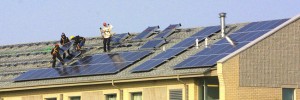The research of professor Joshua Pearce (MSE/ECE) on solar photovoltaic thermal hybrid systems is featured in the press and on radio and television, including the Whig Standard, Materials Today, KROCK1057, CKNW and TV CKWS.
As well, his work appeared on numerous online green-energy news sites.
Here’s a Tiny Solar-Thermal System for Your Tiny House
Lead researcher Joshua Pearce focused on thin-film silicon technology, which is far cheaper than conventional solar cells based on crystalline silicon. For rooftop applications, it also has a weight advantage.
Read more at Clean Technica, by Tina Casey.
Hybrid Solar Electric/Solar Thermal Panels Could Make Rooftop Solar Mainstream
You don’t have to cool down thin-film silicon to make it work. In fact, Pearce’s group discovered that by heating it to solar-thermal operating temperatures, near the boiling point of water, they could make thicker cells that largely overcame the Staebler-Wronski effect. When they applied the thin-film silicon directly to a solar thermal energy collector, they also found that by spike annealing (baking the cell once a day), they boosted the solar cell’s electrical efficiency by over 10 percent.
Read more at Treehugger, by Sami Grover.
Queen’s researchers make solar panel breakthrough
Stephen Harrison and Joshua Pearce of the University’s mechanical and materials engineering department developed a form of solar panel material that can generate both electricity and heat.
Read more at The Kingston Whig-Standard, by Elliot Ferguson.
Photovoltaic thermal power
“These studies open up an entirely new application of amorphous silicon and make a highly-economic PVT possible,” says Dr. Pearce. “We need both solar electricity and solar heating in Canada but we are running into ‘roof real estate’ issues. Now people can have both their solar electricity and solar heating combined in a nice tidy package.”
Read more at Materials Today.
